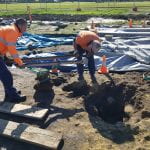For the last week I have been belaboured by a lurgy. Struck down in my prime and driven to my bed, where I watched endless Parks and Recreation until my eyes bled. I think I have found a new role model in the form of one Ron Swanson. Every meal shall now be steak, bacon and Lagavulin, whilst watching re-runs of The Bridge on the River Kwai.
As I festered in my delirium, my mind turned – as it often does – to convicts. Like me, they faced sickness and injury. Unlike me, they had no sick leave and generally had to get on with things. Sometimes, however, at morning muster they could present with their condition and report to the medical officer. Convict stations generally had such an officer, who ensured that convicts were kept fit and healthy enough to carry on their work. In the settled parts of the colony, a medical officer would often travel between stations, placing quite a strain on the gentleman involved – but importantly saving the government a few pounds. At Port Arthur a medical officer was situated at the station for most of its life (though they would often have to visit the outstations). Three separate hospitals were built between 1830-77: the first two were weatherboard buildings situated on the well-ventilated fastness of Settlement Hill. The third was built in 1842, a commodious sandstone structure which still remains on the site today (albeit, a little bit worse for wear).
If you are interested in convict health and welfare at Port Arthur, there’s a great University of Tasmania thesis (and a paper) by historian Louis Marshall which investigates this very thing. There is another thesis from 1996 by Lynette Ross which also examines death and burial practice at the station. Using records like correspondence returns, compiled reports and the Penitentiary Sick Reports (1868-70), Ross and Marshall identified that factors such as diet, accommodation and work regime impacted the health of the convict population. The extent to which they did so varied over the decades, dependent upon the administrative regime, quality of the buildings, or ration allowance. For example, prior to 1833 convicts had been allowed to work in the gardens to contribute to their rations. In that year the station was reclassified as a penal station, with the ‘indulgence’ of growing their own food stripped away. As a direct result, men came down with the heinous disease of scurvy. From the 1860s, Port Arthur’s increasing proportion of aged and infirm meant that circulatory diseases, respiratory infections and musculoskeletal diseases became more prevalent amongst the population.

Though the artist’s grasp of perspective is a bit skewy, he certainly shows that working in the ‘centipede’ gang carrying timber would have been unpleasant (Thomas Lempriere, ca.1834, ‘Gentlemen convicts – The Centipede’, State Library of New South Wales)
Workplace health and safety not being what it is today, the convicts of Port Arthur worked without the benefit of risk assessments and personal protective equipment. Prisoners, often inexperienced, were tasked with undertaking potentially dangerous jobs on a daily basis: timber-getting, quarrying, construction, materials processing. Though accidents were prevalent, one thing Marshall noted was that their rate decreased over the life of the penal settlement. In the 1830s and 1840s the settlement had an injury rate almost double that in the 1860s/70s. This was likely due to the different work regimes the convicts experienced, with the early decades characterised by a focus on intensive manual labour. This primarily involved timber-getting, which involved not only hazardous tree-falling, but carrying of the heavy timbers by gangs of convicts. From the mid-1850s the introduction of tramroads and a sawmill decreased the intensity of the labour required – though of course did not eliminate the danger entirely. One hideous incident in 1869 saw the unfortunate convict John Williams fall into a boiling salt pan (for reducing seawater to salt).
As an industrial place where hammers were wielded, timber sawn, hot metal beaten, leather punched and boilers boiled, the Port Arthur workshops presented an obvious hazard to health – if not life and limb. However, incidents in the workshops appear to have been vanishingly rare. That is of course not to say they did not occur. The general settlement returns we have contain terms like ‘hemorrhagia’, ‘injuria’, ‘lumbago’, ‘fractura’, ‘amputatio’, ‘abrasio’, ‘contusio’ – all of which could have stemmed from incidents that occurred in the workshops. Further research into general correspondence, inquests and the offence records will hopefully shed some light on the conditions experienced by the men working in these spaces, perhaps even allowing us to determine if labouring in the workshops increased – or decreased – a convict’s chance of injury while working at the penal station.



